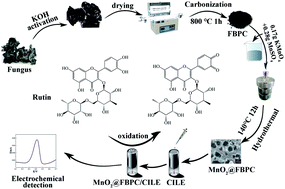A fungus-derived biomass porous carbon–MnO2 nanocomposite-modified electrode for the voltammetric determination of rutin
Abstract
In this study, we designed a simple procedure for the synthesis of fungus-derived biomass porous carbon (FBPC), which was further used to prepare a MnO2@FBPC composite by a hydrothermal method. The MnO2@FBPC nanocomposite showed a porous structure, large specific surface area, and high conductivity, and was modified on the carbon ionic liquid electrode (CILE) to obtain a working electrode for the sensitive voltammetric determination of rutin. The electrochemical response of rutin was studied via cyclic voltammetry with electrochemical parameters calculated. Under the optimal conditions, the linear range for the rutin analysis was obtained by the differential pulse voltammetry from 0.008 to 700.0 μmol L−1 with the detection limit of 2.67 nmol L−1 (3σ). This MnO2@FBPC/CILE was applied to directly detect the rutin concentration in drug and human urine samples with satisfactory results.



 Please wait while we load your content...
Please wait while we load your content...